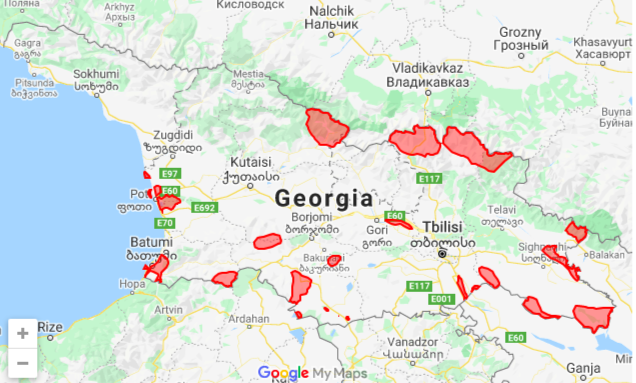Taxonomy
Kingdom Animalia (16266)Phylum Chordata (708)
Class Actinopterygii (120)
Order Acipenseriformes (6)
Family Acipenseridae (6)
Genus Acipenser (5)
Species Acipenser nudiventris
Browse by taxonomy
Simple search by name
Acipenser nudiventris ✓
Fringebarbel sturgeon, Bastard sturgeon;Ship sturgeon;Barbel sturgeon;Fringebarbel sturgeon;Ship;Spiny sturgeon;Thorn Sturgeon, ჯარღალა
Name According To: https://www.iucnredlist.org; http://www.marinespecies.org;https://www.gbif.org;https://www.fishbase.de
Species: nudiventris
Taxon Rank: Species
Scientific Name Authorship: Lovetsky, 1828
Vernacular Name: Fringebarbel sturgeon, Bastard sturgeon;Ship sturgeon;Barbel sturgeon;Fringebarbel sturgeon;Ship;Spiny sturgeon;Thorn Sturgeon
Georgian Name: ჯარღალა
GBD Remarks:
Conservation Status (International): Critically Endangered A2cde ver 3.1 is nearly extinct from the Black Sea basin. The only remaining population occurs in riv. Ural (Russia, Kazakhstan) and possibly Rioni (Georgia - last record from 1997; there are no recent surveys). It is suspected that the species has undergone a population decline of more than 90% in the past three generations (estimated at 45 years). The species is thought to be under threat of global extinction. Overfishing, together with dams construction, water abstraction and drought triggered loss of the spawning ground and caused massive decline.
Conservation Status (national): Georgian Red List (2006): Endangered, national conservation status repeats worldwide status, according to IUCN by 2006. Threats are: overfishing, seizing the largest and mature fish due to poaching and due to bycatch of marine fishing, preventing natural reproduction by dam-building, water abstraction and drought of spawning habitats.
Economic importance (national): Currently low, because of very low density. Potentially interesting species for re-stocking in Rioni. Potentially, economically highly important species.
Methodological approaches: non-extractive counts at spawning sites.
Research activities: Dr. Biol.Sc. Nargiza Ninua, Archil Guchmanidze in Batumi were conducting occasional research during the recent years.
Relevant website: http://www.iucnredlist.org/details/230/0 ; http://www.iucnredlist.org/details/232/0 ; http://www.iucnredlist.org/details/235/0 ; http://www.iucnredlist.org/details/225/0 ; http://www.iucnredlist.org/details/229/0 ; http://www.iucnredlist.org/details/10269/0
Why to monitor: All species rare and important for conservation. Flagship species for Georgia and Caucasus (WWF Action Plan for Caucasus). However, no self-sustainable population does present in Georgia. Systematic annual monitoring of these species would include much and expensive effort for the analysis of the national population, with a high risk not to reveal a single reproductive individual.
Preliminary suggestion: rely on the records of the sturgeons harvest (by-catch and poaching data) and develop non-extractive and non-invasive methods of the monitoring on spawning grounds in rivers.
კონსერვაციული სტატუსი (საერთაშორისო)-Critically Endangered A2cde ver 3.1 თითქმის გამქრალია შავი ზღვის აუზიდან. ორი პოპულაციაა შენარჩუნებული დღემდე - მდინარე ურალში (რუსეთი, ყაზახეთი) და რიონში. საქართველოში ბოლოჯერ დაფიქსირებულია 1997 წელს. არსებული შეფასებით, პოპულაცია 90%-ზე მეტით შემცირდა ბოლო სამი თაობის (დაახლ. 45 წლის) განმავლობაში. სახეობა გლობალურად გადაშენების პირასაა. გადაშენების ძირითადი მიზეზებია ბრაკონიერობა, დამბების მშენებლობა (რაც ხელს უშლის თევზს მდინარეებში იმოძრავოს), წყლის დონის კლება და ქვირითობის ადგილებში პირობების გაუარესება.
კონსერვაციული სტატუსი (ეროვნული): საქართველოს წითელი ნუსხა (2006): EN, ეროვნული სტატუსი 2006 წლის საერთაშორისო სტატუსს იმეორებს. საფრთხეებია: ზღვაში თევზჭერა, განსაკუთრებით დიდი მექვირიტე ინდივიდების ამოღება პოპულაციიდან, დამბების აშენება (რაც ხელს უშლის მდინარეების გამოყენებას საქვირითედ), წყლის დონის დაცემა ბუნებრივ საქვირითეებში. რამდენადაც ზუთხების სიცოცხლის ხანგრძლივობა მაღალია, ზოგ ადგილადს დღესაც მოიპოვება ზრდასრული ინდივიდები, რაც არ ნიშნავს მათ წარმატებულ რეპროდუქციას.
ეკონომიკური მნიშვნელობა (ეროვნული): ამჟამად დაბალი, მცირე რიცხოვნობის გამო. პოტენციალურად ძალიან მნიშვნელოვანი სარეწაო თევზია. პოტენციალურად შესაძლებელია რიონის პოპულაციის აღდგენა.
მონიტორინგის მეთოდები: თვლა ქვირითობის ადგილებში (ამოღების გარეშე)
კვლევითი აქტივობა: ნარგიზა ნინუა (საქართველოს ეროვნული მუზეუმი). არჩილ გუჩმანიძე (ბათუმი). სპეციფიკური პროექტი არ მიმდინარეობს, თუმცა წინა წლებში გარკვეული ინფორმაცია არის დაგროვილი.
სპეციფიკური ინფორმაცია: მორფოლოგიური და გენეტიკური კვლევა არ ადასტურებს Acipenser persicus- ის ტაქსონომიურ ვალიდურიბას. Ruban, G.I., Kholodova, M.V., Kalmykov, V.A. and Sorokin, P.A. 2008. Morphological and molecular genetic study of the Persian Sturgeon Acipenser persicus Borodin (Acipenseridae) taxonomic status. Journal of Ichthyology 48: 891-903.
სასარგებლო ბმულები: http://www.iucnredlist.org/details/230/0 ; http://www.iucnredlist.org/details/232/0 ; http://www.iucnredlist.org/details/235/0 ; http://www.iucnredlist.org/details/225/0 ; http://www.iucnredlist.org/details/229/0 ; http://www.iucnredlist.org/details/10269/0
მონიტორინგის საჭიროება: ყველა ჩამოთვლილი სახეობა იშვიათია და მათი კონსერვაცია ძალზე მნიშვნელოვანია. შეტანილია WWF - ის კავკასიის ბიომრავალფეროვნების სამოქმედო გეგმაში. თუმცა, როგორც ჩანს, საქართველოში მდგრადი პოპულაცია აღარ არსებობს.
რეკომენდაცია. მონაცემები სახეობის ჭერის და შეხვედრის შესახებ შეჯამდეს და შეინახოს ერთიან მონაცემთა ბაზაში. დამუშავდეს ქვირითის მონიტორინგის არაინვაზიური მეთოდები.
Page Authors: Kandaurov A. ,
Information from GBIF about Acipenser nudiventris
GBIF scientific name: Acipenser nudiventris Lovetsky, 1828
GBIF taxonomic status: ACCEPTED

Conservation Status
This section is under construction
National Red List Status: CR
IUCN Red List Status: CR
Protection status: Not defined
Reason: A2cde
Trend: Declining
Native/Introduced: Native
Comment: Critically Endangered D ; 3.1: IUCN, 2001
Georgian Name: ჯარღალა
English Name: Fringebarbel sturgeon, Bastard sturgeon;Ship sturgeon;Barbel sturgeon;Fringebarbel sturgeon;Ship;Spiny sturgeon;Thorn Sturgeon
Synonyms: Acipenser nudiventris derjavini;Acipenser schypa;Acipenser turritus ;
Taxonomy according to: https://www.iucnredlist.org; http://www.marinespecies.org;https://www.gbif.org;https://www.fishbase.de
References: Current and Historical Status of Sturgeon (Acipenseridae, Osteichthyes) in Georgia;A.Guchmanidze;STATUS AND PROTECTION OF GLOBALLY THREATENED SPECIES IN THE CAUCASUS;Tbilisi, Georgia,December 2009pp. 171-177;დისერტაცია ა.გუჩმანიძე:'საქართველოს შავი ზღვის
Evaluated By: Mikeladze R, Mgeladze M, Goradze R, Japoshvili B, Epitashvili G, Kuljanishvili T.
Date evaluated: Nov 2021

